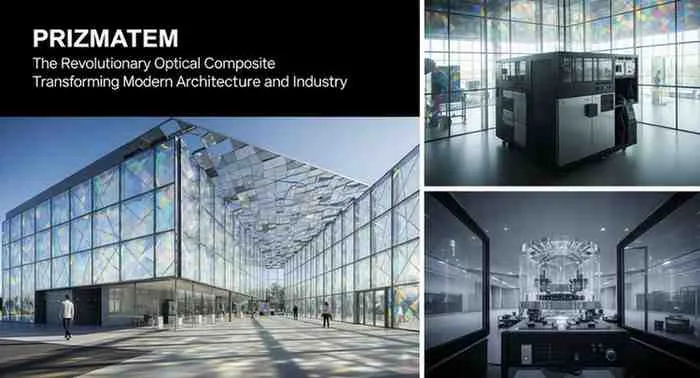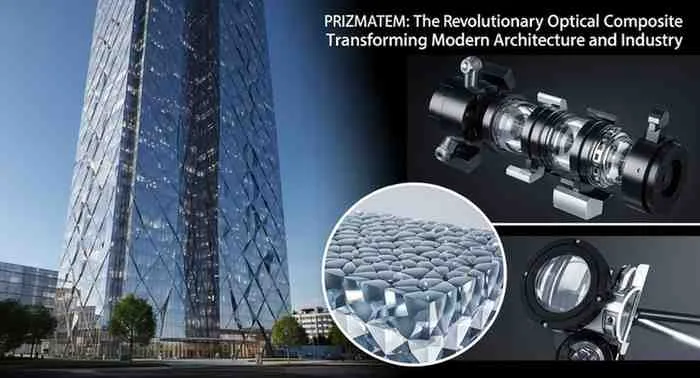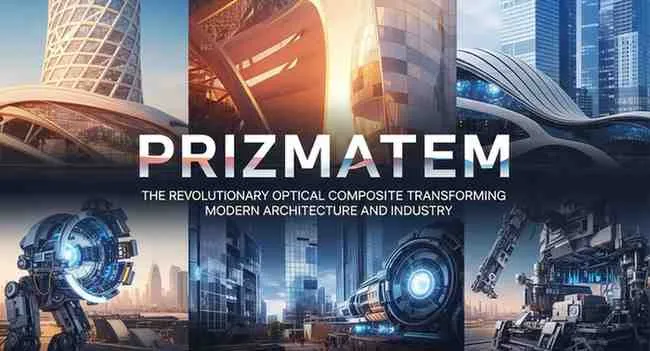The world of advanced materials has witnessed remarkable innovations in recent years, but few have captured the attention of architects, engineers, and designers quite like Prizmatem. This groundbreaking optical composite represents a paradigm shift in how we approach transparent materials, offering unprecedented performance characteristics that challenge traditional optical glass solutions.
What makes Prizmatem so revolutionary? This transparent composite combines the optical clarity of precision glass with the durability and versatility of modern polymeric materials, creating a prism-like material that opens new possibilities across industries. From cutting-edge architectural applications to specialized industrial uses, Prizmatem is reshaping our understanding of what’s possible with optical-grade materials.
In this comprehensive guide, we’ll explore everything you need to know about Prizmatem, from its innovative manufacturing process to practical applications, cost comparisons, and maintenance requirements. Whether you’re an architect considering Prizmatem panels for your next project or an engineer evaluating optical materials, this article will provide the insights you need to make informed decisions.
What is Prizmatem? Understanding This Revolutionary Optical Composite
Prizmatem represents a breakthrough in optical composite technology, combining advanced materials science with precision manufacturing to create a transparent composite unlike anything previously available. At its core, Prizmatem is a sophisticated blend of silica micro-prisms embedded within a carefully engineered polymeric matrix composite.
The material achieves its remarkable properties through a unique prismatic light-guiding architecture that manipulates light transmission in ways traditional materials cannot. With a refractive index of 1.60, Prizmatem offers superior optical performance while maintaining the structural advantages of composite materials.
Key Characteristics of Prizmatem
The optical composite distinguishes itself through several critical properties:
Optical Excellence: Prizmatem delivers crystal-clear transparency with minimal optical distortion, rivaling the performance of precision optical glass while offering enhanced light-guiding capabilities through its prismatic structure.
Impact Resistance: Unlike traditional glass, these impact-resistant transparent sheets can withstand significant mechanical stress without shattering, making them ideal for high-traffic environments and safety-critical applications.
Thermal Stability: Advanced nanofillers for heat tolerance ensure Prizmatem maintains its optical and structural properties across a wide temperature range, from -40°C to 120°C under normal operating conditions.
UV Resistance: The UV-cure optical material composition provides exceptional resistance to ultraviolet degradation, ensuring long-term optical clarity even in direct sunlight exposure.
How Prizmatem is Made: The Advanced Manufacturing Process
Understanding how Prizmatem is manufactured reveals the sophisticated engineering behind this innovative material. The production process represents years of research and development in materials science and optical engineering.
Stage 1: Silica Micro-Prism Production
The manufacturing process begins with the creation of precisely engineered silica micro-prisms. These microscopic structures form the optical backbone of Prizmatem, requiring nanometer-level precision in their geometry and surface finish.
The silica micro-prisms undergo a specialized treatment process that optimizes their refractive properties and ensures perfect integration with the polymeric matrix. Each micro-prism is designed to specific optical tolerances that enable the material’s unique light-guiding characteristics.
Stage 2: Polymeric Matrix Preparation
The polymeric matrix composite serves as both the structural foundation and optical medium for the embedded micro-prisms. This advanced polymer system is formulated with specific additives and nanofillers that enhance thermal stability, UV resistance, and mechanical properties.
The polymer formulation process involves precise temperature and pressure control to ensure optimal molecular alignment and cross-linking density. This careful control directly impacts the final optical quality and mechanical performance of the Prizmatem sheets.
Stage 3: UV-Cure Integration Process
The final manufacturing stage utilizes advanced UV-cure optical material technology to bond the silica micro-prisms within the polymeric matrix. This process occurs in specialized clean-room environments under controlled atmospheric conditions.
UV curing provides several advantages over thermal curing methods, including reduced thermal stress, improved optical clarity, and enhanced dimensional stability. The curing process is carefully monitored to ensure uniform cross-linking throughout the material thickness.
Quality Control and Optical Testing
Each batch of Prizmatem undergoes rigorous quality control testing, including optical transmission measurements, refractive index verification, and mechanical property validation. This comprehensive testing ensures every sheet meets the stringent requirements for optical-grade material applications.

Prizmatem vs Precision Optical Glass: A Comprehensive Performance Analysis
When evaluating optical materials, the comparison between Prizmatem and traditional precision optical glass reveals significant advantages for the innovative composite in many applications.
Optical Performance Comparison
Light Transmission: Prizmatem achieves exceptional light transmission rates, with typical values exceeding 92% across the visible spectrum. While precision optical glass may achieve slightly higher transmission rates in some wavelengths, Prizmatem’s prismatic light-guiding architecture provides superior light distribution and control.
Optical Clarity: The refractive index of 1.60 positions Prizmatem in an optimal range for architectural and industrial applications, providing excellent optical clarity while enabling unique light manipulation capabilities unavailable with standard glass.
Distortion Control: The prism-like material structure allows for controlled optical distortion effects when desired, while maintaining exceptional clarity for standard viewing applications.
Mechanical Properties Advantage
Impact Resistance: Prizmatem demonstrates superior impact resistance compared to optical glass, with fracture energy absorption rates 5-10 times higher than comparable glass sheets. This advantage makes it particularly valuable in safety-critical applications.
Thermal Expansion: The coefficient of thermal expansion for Prizmatem is carefully engineered to minimize stress development across temperature ranges, reducing the risk of thermal shock failure common with glass materials.
Weight Considerations: Prizmatem sheets typically weigh 40-50% less than equivalent optical glass, providing significant advantages in architectural applications where structural loading is a concern.
Durability and Maintenance Benefits
Weather Resistance: The transparent composite demonstrates exceptional resistance to environmental degradation, including UV exposure, thermal cycling, and chemical exposure from atmospheric pollutants.
Scratch Resistance: While not as hard as glass, Prizmatem’s surface can be treated with protective coatings that provide excellent scratch resistance for most applications.
Repair and Replacement: Unlike glass, minor damage to Prizmatem surfaces can often be polished out, extending service life and reducing maintenance costs.
Industrial and Architectural Applications of Prizmatem
The unique properties of this optical composite have opened new possibilities across multiple industries, from high-end architectural projects to specialized industrial applications.
Architectural Applications
Curtain Wall Systems: Prizmatem panels are increasingly used in modern curtain wall designs, where their light weight and impact resistance provide significant advantages over traditional glass. The prismatic light-guiding architecture enables innovative lighting effects and energy-efficient daylighting strategies.
Skylights and Roof Glazing: The material’s excellent weather resistance and thermal stability make it ideal for overhead glazing applications. Prizmatem skylights provide superior light distribution while maintaining structural integrity under snow loads and thermal stress.
Interior Partitions: The optical-grade material properties make Prizmatem excellent for interior partition systems where visual transparency must be combined with acoustic performance and safety requirements.
Industrial and Specialized Applications
Optical Equipment Housing: The combination of optical clarity and impact resistance makes Prizmatem valuable for protective housings in optical instruments and measurement equipment.
Transportation Infrastructure: Impact-resistant transparent sheets are finding applications in transportation projects, from bus stops to railway stations, where vandalism resistance is critical.
Agricultural Structures: The UV resistance and thermal stability of Prizmatem make it suitable for greenhouse applications and agricultural buildings requiring controlled light transmission.
Emerging Applications
Research continues into new applications for this versatile material, including solar concentrator systems, LED light guides, and advanced display technologies. The prismatic light-guiding architecture opens possibilities for applications not feasible with traditional optical materials.
Installation and Maintenance: Best Practices for Prizmatem Systems
Proper installation and maintenance are crucial for realizing the full benefits of Prizmatem optical composite systems. Understanding the unique characteristics of this material ensures optimal performance and longevity.
Installation Guidelines
Structural Considerations: While Prizmatem is lighter than glass, proper structural support remains essential. The material’s thermal expansion characteristics must be accommodated in the mounting system design.
Sealing and Weatherproofing: The edge sealing of Prizmatem panels requires specific sealant types compatible with the polymeric matrix. Traditional glass sealants may not provide optimal adhesion and long-term performance.
Handling Precautions: Although more impact-resistant than glass, Prizmatem sheets require careful handling during installation to prevent surface damage. Specialized lifting equipment may be necessary for large panels.
How to Clean and Maintain Prizmatem Surfaces
Routine Cleaning: Regular cleaning maintains optical clarity and prevents the buildup of environmental contaminants. Use mild soap solutions with soft cloths or squeegees to avoid surface scratching.
Specialized Cleaning Products: Certain cleaning products may affect the polymeric matrix or any applied coatings. Always verify compatibility before using new cleaning agents on Prizmatem surfaces.
Inspection Protocols: Regular inspection for signs of UV degradation, thermal stress, or mechanical damage allows for proactive maintenance and extends service life.
Long-term Maintenance Strategies
Protective Coatings: Application of appropriate protective coatings can enhance scratch resistance and ease of cleaning. These coatings may require periodic renewal depending on environmental exposure.
Replacement Planning: While Prizmatem offers excellent durability, establishing replacement schedules based on application requirements and environmental conditions ensures optimal performance throughout the building’s lifecycle.
Prizmatem Sheet Pricing and Commercial Considerations
Understanding the cost structure and commercial aspects of Prizmatem is essential for project planning and budgeting decisions.
Pricing Structure Analysis
Prizmatem Sheet Pricing: Current market prices for standard Prizmatem sheets typically range from $45-85 per square meter, depending on thickness, size, and quantity ordered. This pricing positions the material competitively against high-performance architectural glass products.
Prizmatem vs Acrylic Cost Comparison: While initial costs may be higher than standard acrylic sheets, the superior optical properties and durability of Prizmatem often provide better long-term value in demanding applications.
Volume Pricing Advantages: Prizmatem bulk order for architects and large construction projects can achieve significant cost savings, with discounts of 15-25% available for orders exceeding 1000 square meters.
Where to Buy Prizmatem Panels
Authorized Distributors: Order Prizmatem optical panels through authorized distributors who can provide technical support and ensure authentic product delivery.
Online Purchasing: Some suppliers offer the ability to buy Prizmatem sheets online, providing convenient ordering and delivery tracking for smaller quantities.
Custom Fabrication: Many applications require custom-sized panels or specialized edge treatments. Working with fabricators experienced in Prizmatem processing ensures optimal results.
Commercial Terms and Considerations
Lead Times: Standard Prizmatem products typically have lead times of 4-8 weeks, while custom specifications may require 8-12 weeks for delivery.
Warranty Terms: Most suppliers provide warranties covering material defects and optical performance degradation, typically ranging from 5-10 years depending on application.
Prizmatem Discount Codes: Promotional pricing may be available through manufacturer programs or distributor partnerships, particularly for new applications or large projects.

Environmental Impact and Sustainability Benefits
The environmental considerations of building materials have become increasingly important in modern construction and industrial applications. Prizmatem offers several sustainability advantages over traditional optical materials.
Manufacturing Environmental Impact
Energy Efficiency: The UV-cure optical material manufacturing process requires significantly less energy than glass production, with reduced carbon emissions throughout the production cycle.
Raw Material Sourcing: The polymeric matrix utilizes advanced recycling technologies, incorporating post-consumer recycled content where possible without compromising optical performance.
Waste Reduction: Manufacturing waste from Prizmatem production can often be reprocessed into the polymeric matrix, creating a more circular production model.
Lifecycle Environmental Benefits
Transportation Efficiency: The reduced weight of Prizmatem sheets compared to glass reduces transportation energy requirements and associated emissions.
Building Energy Performance: The prismatic light-guiding architecture can improve daylighting efficiency in buildings, reducing artificial lighting energy consumption.
End-of-Life Management: Unlike glass, Prizmatem can be mechanically recycled or used as feedstock for energy recovery systems, providing multiple end-of-life options.
Sustainability Certifications
Many Prizmatem products are eligible for green building certification credits under LEED, BREEAM, and other sustainability rating systems, supporting sustainable design objectives.
Real-World Case Studies: Prizmatem in Action
Examining actual implementations of Prizmatem provides valuable insights into the material’s performance and benefits in real-world applications.
Case Study 1: Metropolitan Transit Authority Shelter System
A major metropolitan transit authority replaced traditional glass panels in bus shelter systems with Prizmatem sheets after experiencing high vandalism and replacement costs. The project covered 450 bus shelters across the urban area.
Results: Vandalism-related replacement dropped by 78% over two years, while maintenance costs decreased by 62%. The prismatic light-guiding architecture improved visibility and perceived safety at night.
Lessons Learned: Proper edge sealing proved critical in high-humidity environments, requiring specification of compatible sealant systems.
Case Study 2: Corporate Headquarters Curtain Wall
A Fortune 500 company incorporated Prizmatem panels into their new headquarters curtain wall system, seeking to achieve both architectural distinction and performance benefits.
Performance Outcomes: Energy modeling showed 12% reduction in artificial lighting loads due to improved daylighting distribution. The building achieved LEED Platinum certification with credits for innovative materials use.
Design Integration: The prismatic light-guiding architecture created unique interior lighting effects that became a signature feature of the building’s aesthetic identity.
Case Study 3: Agricultural Research Facility
A university agricultural research facility utilized Prizmatem panels in greenhouse construction, requiring precise light transmission control for plant growth studies.
Technical Performance: The material’s UV resistance and thermal stability maintained consistent optical properties over three years of continuous outdoor exposure. Light transmission characteristics remained within 2% of original specifications.
Research Benefits: The controlled light distribution enabled more precise experimental conditions compared to traditional greenhouse glazing materials.
Frequently Asked Questions About Prizmatem
What is Prizmatem’s expected lifespan?
Under normal architectural applications, Prizmatem typically maintains its optical and mechanical properties for 20-25 years. Accelerated aging tests suggest even longer service life in protected environments, while harsh outdoor exposure may reduce lifespan to 15-20 years.
Can Prizmatem be cut or fabricated on-site?
While possible, field fabrication of Prizmatem requires specialized tools and techniques. The polymeric matrix can be cut with diamond-blade saws or water-jet cutting systems, but edge polishing is typically necessary to maintain optical quality. Most applications benefit from factory fabrication to ensure optimal results.
How does thermal expansion compare to glass?
Prizmatem’s thermal expansion coefficient is approximately 2.5 times higher than glass, requiring accommodation in mounting systems. However, the material’s flexibility reduces stress concentrations that commonly cause glass failure during thermal cycling.
Is Prizmatem recyclable?
Yes, Prizmatem can be mechanically recycled into new polymeric matrix material, though the silica micro-prisms may require separation for optimal recycling efficiency. Many manufacturers operate take-back programs for end-of-life material recovery.
What fire safety certifications does Prizmatem hold?
Most Prizmatem formulations meet Class A fire safety ratings when tested according to ASTM E84 standards. The material is self-extinguishing and produces minimal smoke generation compared to many organic polymers.
Can Prizmatem be used in structural glazing applications?
While Prizmatem offers excellent mechanical properties, structural glazing applications require engineering analysis to ensure adequate safety factors. The material’s long-term creep characteristics must be considered in structural calculations.
Advantages and Limitations of Prizmatem Technology
Key Advantages
Superior Impact Resistance: The transparent composite offers exceptional impact resistance compared to glass, reducing safety risks and replacement costs in high-traffic environments.
Innovative Optical Properties: The prismatic light-guiding architecture enables unique lighting effects and improved daylighting efficiency unavailable with traditional materials.
Weight Reduction: Significant weight savings compared to glass reduce structural requirements and installation complexity.
Design Flexibility: The material can be formed into complex shapes and configurations difficult to achieve with glass manufacturing processes.
Environmental Benefits: Lower manufacturing energy requirements and recyclability advantages support sustainable design objectives.
Current Limitations
Cost Premium: Initial material costs are typically higher than standard architectural glass, though lifecycle cost analysis often favors Prizmatem in appropriate applications.
Thermal Expansion: Higher thermal expansion coefficients require careful consideration in mounting system design and may limit applications in extreme temperature environments.
Surface Hardness: While scratch-resistant, Prizmatem surfaces are not as hard as glass and may require protective treatments in abrasive environments.
Limited Track Record: As a relatively new material, long-term performance data is still being accumulated, particularly for specialized applications.
Manufacturing Capacity: Current production capacity may limit availability for very large projects, requiring advance planning and scheduling.

The Future of Prizmatem and Optical Composite Technology
The development of Prizmatem represents just the beginning of what’s possible with advanced optical composite materials. Ongoing research and development efforts continue to expand the capabilities and applications of this innovative technology.
Emerging Developments
Enhanced Formulations: New polymeric matrix formulations are being developed to improve specific properties such as fire resistance, chemical compatibility, and thermal stability.
Smart Material Integration: Research into incorporating electrochromic and thermochromic properties could enable dynamic optical control capabilities.
Nanotechnology Advances: Advanced nanofillers for heat tolerance and other properties continue to improve, enabling performance in increasingly demanding applications.
Market Expansion
Geographic Growth: International adoption of Prizmatem technology is expanding, with new manufacturing facilities planned in Europe and Asia to serve growing global demand.
Application Diversification: New applications in automotive, aerospace, and consumer electronics markets are driving continued innovation and development.
Standardization Efforts: Industry standards development will facilitate broader adoption and ensure consistent quality across suppliers and applications.
Technology Integration
The future of optical composite materials lies in integration with other advanced technologies. Smart building systems, renewable energy applications, and advanced manufacturing techniques will all benefit from continued Prizmatem development.
Research into bio-based polymeric matrix materials and sustainable manufacturing processes promises to further enhance the environmental benefits of this innovative technology.
Conclusion: Prizmatem’s Role in the Future of Architecture and Industry
Prizmatem represents a fundamental advancement in optical composite technology, offering architects, engineers, and designers unprecedented capabilities in transparent material applications. The combination of optical excellence, mechanical durability, and design flexibility positions this innovative material at the forefront of modern building and industrial applications.
The prismatic light-guiding architecture that defines Prizmatem opens new possibilities for energy-efficient design, architectural aesthetics, and functional performance that simply weren’t possible with traditional materials. As we’ve explored throughout this comprehensive analysis, the material’s advantages extend far beyond simple glass replacement to enable entirely new approaches to building design and industrial applications.
For professionals considering Prizmatem for their projects, the key factors of performance, cost, and sustainability create a compelling case for adoption in appropriate applications. While the material may command a premium over traditional alternatives, the lifecycle benefits and unique capabilities often justify the investment.
The continued development of optical composite technology promises even greater capabilities in the future. As manufacturing capacity expands and new formulations emerge, Prizmatem and related materials will likely become increasingly important tools in the architect’s and engineer’s toolkit.
Whether you’re planning a cutting-edge architectural project, designing industrial equipment, or exploring new applications for advanced materials, Prizmatem deserves serious consideration. The combination of proven performance, innovative capabilities, and ongoing development makes it a material truly suited for the challenges and opportunities of modern design and construction.
Ready to explore how Prizmatem can transform your next project? Connect with authorized distributors and technical specialists to discuss your specific requirements and discover the possibilities that this revolutionary optical composite can bring to your applications. Share your experiences and questions in the comments below, and don’t forget to share this guide with colleagues who might benefit from learning about this innovative material technology.
The future of transparent materials is here, and Prizmatem is leading the way toward more sustainable, durable, and innovative solutions for the built environment.



